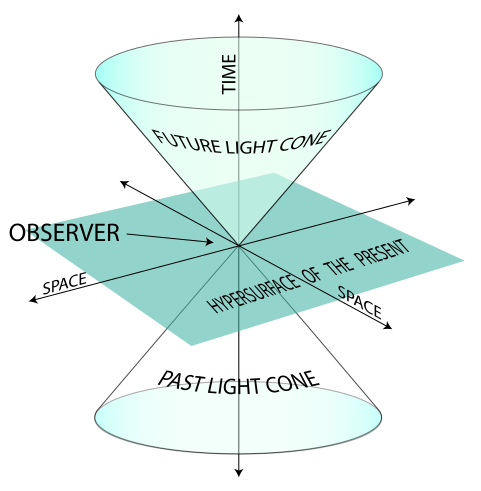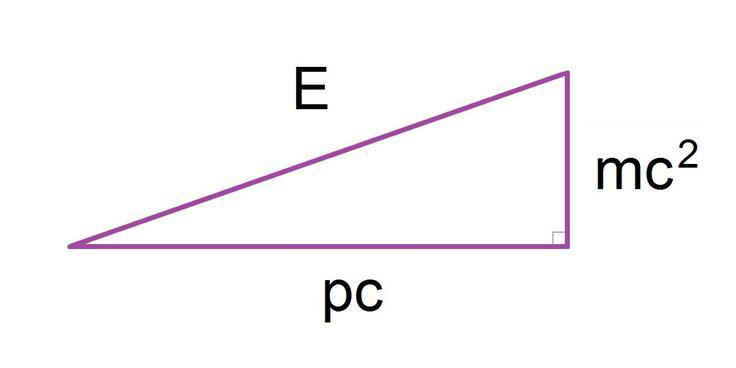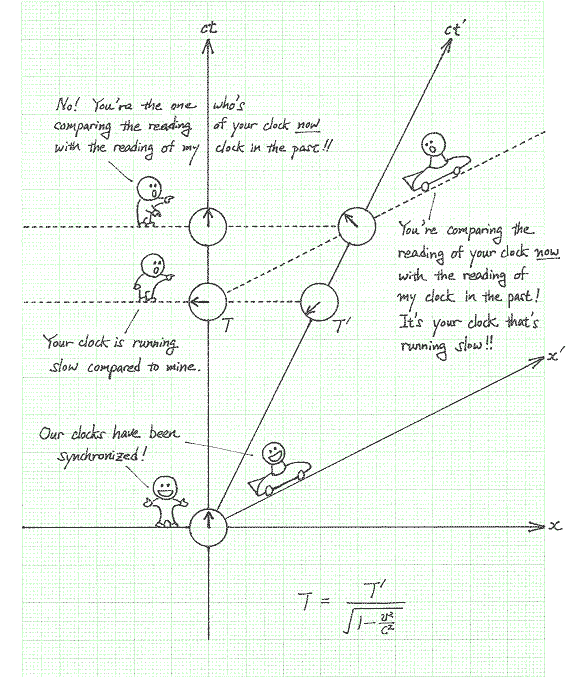 What is Motion?
https://en.wikipedia.org/wiki/Motion_(physics)
https://en.wikipedia.org/wiki/Galilean_invariance
Galilean invariance or Galilean relativity states that the
laws of motion are the same in all inertial frames. Galileo
Galilei first described this principle in 1632 in his
Dialogue Concerning the Two Chief World Systems using the
example of a ship travelling at constant velocity, without
rocking, on a smooth sea; any observer doing experiments
below the deck would not be able to tell whether the ship
was moving or stationary.
Specifically, the term Galilean invariance today usually
refers to this principle as applied to Newtonian mechanics,
that is, Newton's laws hold in all frames related to one
another by a Galilean transformation. In other words, all
frames related to one another by such a transformation are
inertial (meaning, Newton's equation of motion is valid in
these frames). In this context it is sometimes called
Newtonian relativity
The Principle of Relativity
https://en.wikipedia.org/wiki/Principle_of_relativity
In physics, the principle of relativity is the requirement
that the equations describing the laws of physics have the
same form in all admissible frames of reference.
For example, in the framework of special relativity the
Maxwell equations have the same form in all inertial frames
of reference. In the framework of general relativity the
Maxwell equations or the Einstein field equations have the
same form in arbitrary frames of reference.
Several principles of relativity have been successfully
applied throughout science, whether implicitly (as in
Newtonian mechanics) or explicitly (as in Albert Einstein's
special relativity and general relativity).
What is Space?
https://en.wikipedia.org/wiki/Space
Space is the boundless three-dimensional extent in which
objects and events have relative position and direction.
Physical space is often conceived in three linear
dimensions, although modern physicists usually consider it,
with time, to be part of a boundless four-dimensional
continuum known as spacetime. The concept of space is
considered to be of fundamental importance to an
understanding of the physical universe.
What is Distance?
https://en.wikipedia.org/wiki/Distance
Distance is a numerical description of how far apart objects
are. In physics or everyday usage, distance may refer to a
physical length, or an estimation based on other criteria
(e.g. "two counties over"). In most cases, "distance from A
to B" is interchangeable with "distance from B to A". In
mathematics, a distance function or metric is a
generalization of the concept of physical distance. A metric
is a function that behaves according to a specific set of
rules, and is a way of describing what it means for elements
of some space to be "close to" or "far away from" each other.
What is Time?
https://en.wikipedia.org/wiki/Time_in_physics
Time in physics is defined by its measurement: time is what
a clock reads. In classical, non-relativistic physics it is
a scalar quantity and, like length, mass, and charge, is
usually described as a fundamental quantity. Time can be
combined mathematically with other physical quantities to
derive other concepts such as motion, kinetic energy and
time-dependent fields.
What is Mass
https://en.wikipedia.org/wiki/Mass#Inertial_mass
https://en.wikipedia.org/wiki/Mass#Inertial_vs._gravitational_mass
Mass is both a property of a physical body and a measure of
its resistance to acceleration (a change in its state of
motion) when a net force is applied. It also determines the
strength of its mutual gravitational attraction to other
bodies.
What is Momentum
https://en.wikipedia.org/wiki/Momentum
In Newtonian mechanics, linear momentum, translational
momentum, or simply momentum (pl. momenta) is the product of
the mass and velocity of an object. It is a
three-dimensional vector quantity, possessing a direction
and a magnitude. If m is an object's mass and v is the
velocity (also a vector), then the momentum is
p = mv
In SI units, it is measured in kilogram meters per second
(kg-m/s). Newton's second law of motion states that a body's
rate of change in momentum is equal to the net force acting
on it.
Momentum depends on the frame of reference, but in any
inertial frame it is a conserved quantity, meaning that if a
closed system is not affected by external forces, its total
linear momentum does not change. Momentum is also conserved
in special relativity (with a modified formula) and, in a
modified form, in electrodynamics, quantum mechanics,
quantum field theory, and general relativity. It is an
expression of one of the fundamental symmetries of space and
time, that of translational symmetry.
What is Energy?
https://en.wikipedia.org/wiki/Energy
https://en.wikipedia.org/wiki/Conservation_of_energy
https://en.wikipedia.org/wiki/Noether's_theorem
In physics, energy is the property that must be transferred
to an object in order to perform work on, or to heat, the
object. Energy is a conserved quantity; the law of
conservation of energy states that energy can be converted
in form, but not created or destroyed.
Energy-momentum
https://hepweb.ucsd.edu/ph110b/110b_notes/node54.html
In physics, the energy-momentum relation, or relativistic
dispersion relation, is the relativistic equation relating
any object's rest (intrinsic) mass, total energy, and
momentum:
What is Motion?
https://en.wikipedia.org/wiki/Motion_(physics)
https://en.wikipedia.org/wiki/Galilean_invariance
Galilean invariance or Galilean relativity states that the
laws of motion are the same in all inertial frames. Galileo
Galilei first described this principle in 1632 in his
Dialogue Concerning the Two Chief World Systems using the
example of a ship travelling at constant velocity, without
rocking, on a smooth sea; any observer doing experiments
below the deck would not be able to tell whether the ship
was moving or stationary.
Specifically, the term Galilean invariance today usually
refers to this principle as applied to Newtonian mechanics,
that is, Newton's laws hold in all frames related to one
another by a Galilean transformation. In other words, all
frames related to one another by such a transformation are
inertial (meaning, Newton's equation of motion is valid in
these frames). In this context it is sometimes called
Newtonian relativity
The Principle of Relativity
https://en.wikipedia.org/wiki/Principle_of_relativity
In physics, the principle of relativity is the requirement
that the equations describing the laws of physics have the
same form in all admissible frames of reference.
For example, in the framework of special relativity the
Maxwell equations have the same form in all inertial frames
of reference. In the framework of general relativity the
Maxwell equations or the Einstein field equations have the
same form in arbitrary frames of reference.
Several principles of relativity have been successfully
applied throughout science, whether implicitly (as in
Newtonian mechanics) or explicitly (as in Albert Einstein's
special relativity and general relativity).
What is Space?
https://en.wikipedia.org/wiki/Space
Space is the boundless three-dimensional extent in which
objects and events have relative position and direction.
Physical space is often conceived in three linear
dimensions, although modern physicists usually consider it,
with time, to be part of a boundless four-dimensional
continuum known as spacetime. The concept of space is
considered to be of fundamental importance to an
understanding of the physical universe.
What is Distance?
https://en.wikipedia.org/wiki/Distance
Distance is a numerical description of how far apart objects
are. In physics or everyday usage, distance may refer to a
physical length, or an estimation based on other criteria
(e.g. "two counties over"). In most cases, "distance from A
to B" is interchangeable with "distance from B to A". In
mathematics, a distance function or metric is a
generalization of the concept of physical distance. A metric
is a function that behaves according to a specific set of
rules, and is a way of describing what it means for elements
of some space to be "close to" or "far away from" each other.
What is Time?
https://en.wikipedia.org/wiki/Time_in_physics
Time in physics is defined by its measurement: time is what
a clock reads. In classical, non-relativistic physics it is
a scalar quantity and, like length, mass, and charge, is
usually described as a fundamental quantity. Time can be
combined mathematically with other physical quantities to
derive other concepts such as motion, kinetic energy and
time-dependent fields.
What is Mass
https://en.wikipedia.org/wiki/Mass#Inertial_mass
https://en.wikipedia.org/wiki/Mass#Inertial_vs._gravitational_mass
Mass is both a property of a physical body and a measure of
its resistance to acceleration (a change in its state of
motion) when a net force is applied. It also determines the
strength of its mutual gravitational attraction to other
bodies.
What is Momentum
https://en.wikipedia.org/wiki/Momentum
In Newtonian mechanics, linear momentum, translational
momentum, or simply momentum (pl. momenta) is the product of
the mass and velocity of an object. It is a
three-dimensional vector quantity, possessing a direction
and a magnitude. If m is an object's mass and v is the
velocity (also a vector), then the momentum is
p = mv
In SI units, it is measured in kilogram meters per second
(kg-m/s). Newton's second law of motion states that a body's
rate of change in momentum is equal to the net force acting
on it.
Momentum depends on the frame of reference, but in any
inertial frame it is a conserved quantity, meaning that if a
closed system is not affected by external forces, its total
linear momentum does not change. Momentum is also conserved
in special relativity (with a modified formula) and, in a
modified form, in electrodynamics, quantum mechanics,
quantum field theory, and general relativity. It is an
expression of one of the fundamental symmetries of space and
time, that of translational symmetry.
What is Energy?
https://en.wikipedia.org/wiki/Energy
https://en.wikipedia.org/wiki/Conservation_of_energy
https://en.wikipedia.org/wiki/Noether's_theorem
In physics, energy is the property that must be transferred
to an object in order to perform work on, or to heat, the
object. Energy is a conserved quantity; the law of
conservation of energy states that energy can be converted
in form, but not created or destroyed.
Energy-momentum
https://hepweb.ucsd.edu/ph110b/110b_notes/node54.html
In physics, the energy-momentum relation, or relativistic
dispersion relation, is the relativistic equation relating
any object's rest (intrinsic) mass, total energy, and
momentum:
 E2 = (m0c2)2 + (pc)2
holds for a system, such as a particle or macroscopic body,
having intrinsic rest mass m0, total energy E, and a
momentum of magnitude p, where the constant c is the speed
of light, assuming the special relativity case of flat
spacetime.
The energy-momentum relation is consistent with the familiar
mass-energy relation in both its interpretations: E = mc2
relates total energy E to the (total) relativistic mass m
(alternatively denoted mrel or mtot ), while E0 = m0c2
relates rest energy E0 to (invariant) rest mass which we
denote m0. Unlike either of those equations, the
energy-momentum equation relates the total energy to the
rest mass m0. All three equations hold true simultaneously.
https://www.youtube.com/watch?v=NnMIhxWRGNw
What is Spacetime
https://en.wikipedia.org/wiki/Spacetime
https://en.wikipedia.org/wiki/Minkowski_diagram
E2 = (m0c2)2 + (pc)2
holds for a system, such as a particle or macroscopic body,
having intrinsic rest mass m0, total energy E, and a
momentum of magnitude p, where the constant c is the speed
of light, assuming the special relativity case of flat
spacetime.
The energy-momentum relation is consistent with the familiar
mass-energy relation in both its interpretations: E = mc2
relates total energy E to the (total) relativistic mass m
(alternatively denoted mrel or mtot ), while E0 = m0c2
relates rest energy E0 to (invariant) rest mass which we
denote m0. Unlike either of those equations, the
energy-momentum equation relates the total energy to the
rest mass m0. All three equations hold true simultaneously.
https://www.youtube.com/watch?v=NnMIhxWRGNw
What is Spacetime
https://en.wikipedia.org/wiki/Spacetime
https://en.wikipedia.org/wiki/Minkowski_diagram
 In physics, spacetime is any mathematical model that fuses
the three dimensions of space and the one dimension of time
into a single four-dimensional continuum. Spacetime diagrams
are useful in visualizing and understanding relativistic
effects such as how different observers perceive where and
when events occur.
Time Dilation using Spacetime Diagram
http://www1.phys.vt.edu/~takeuchi/relativity/notes/section12.html
In physics, spacetime is any mathematical model that fuses
the three dimensions of space and the one dimension of time
into a single four-dimensional continuum. Spacetime diagrams
are useful in visualizing and understanding relativistic
effects such as how different observers perceive where and
when events occur.
Time Dilation using Spacetime Diagram
http://www1.phys.vt.edu/~takeuchi/relativity/notes/section12.html
 Interpreting Spacetime Diagrams
https://en.wikibooks.org/wiki/Special_Relativity/Spacetime#Interpreting_space-time_diagrams
http://www1.phys.vt.edu/~takeuchi/relativity/practice/
http://www1.phys.vt.edu/~takeuchi/relativity/notes/section12.html
https://www.youtube.com/watch?v=ajhFNcUTJI0
https://en.wikipedia.org/wiki/Spacetime#Spacetime_interval
Interpreting Spacetime Diagrams
https://en.wikibooks.org/wiki/Special_Relativity/Spacetime#Interpreting_space-time_diagrams
http://www1.phys.vt.edu/~takeuchi/relativity/practice/
http://www1.phys.vt.edu/~takeuchi/relativity/notes/section12.html
https://www.youtube.com/watch?v=ajhFNcUTJI0
https://en.wikipedia.org/wiki/Spacetime#Spacetime_interval
 sam.wormley@gmail.com
sam.wormley@gmail.com
What is Motion? https://en.wikipedia.org/wiki/Motion_(physics) https://en.wikipedia.org/wiki/Galilean_invariance Galilean invariance or Galilean relativity states that the laws of motion are the same in all inertial frames. Galileo Galilei first described this principle in 1632 in his Dialogue Concerning the Two Chief World Systems using the example of a ship travelling at constant velocity, without rocking, on a smooth sea; any observer doing experiments below the deck would not be able to tell whether the ship was moving or stationary. Specifically, the term Galilean invariance today usually refers to this principle as applied to Newtonian mechanics, that is, Newton's laws hold in all frames related to one another by a Galilean transformation. In other words, all frames related to one another by such a transformation are inertial (meaning, Newton's equation of motion is valid in these frames). In this context it is sometimes called Newtonian relativity The Principle of Relativity https://en.wikipedia.org/wiki/Principle_of_relativity In physics, the principle of relativity is the requirement that the equations describing the laws of physics have the same form in all admissible frames of reference. For example, in the framework of special relativity the Maxwell equations have the same form in all inertial frames of reference. In the framework of general relativity the Maxwell equations or the Einstein field equations have the same form in arbitrary frames of reference. Several principles of relativity have been successfully applied throughout science, whether implicitly (as in Newtonian mechanics) or explicitly (as in Albert Einstein's special relativity and general relativity). What is Space? https://en.wikipedia.org/wiki/Space Space is the boundless three-dimensional extent in which objects and events have relative position and direction. Physical space is often conceived in three linear dimensions, although modern physicists usually consider it, with time, to be part of a boundless four-dimensional continuum known as spacetime. The concept of space is considered to be of fundamental importance to an understanding of the physical universe. What is Distance? https://en.wikipedia.org/wiki/Distance Distance is a numerical description of how far apart objects are. In physics or everyday usage, distance may refer to a physical length, or an estimation based on other criteria (e.g. "two counties over"). In most cases, "distance from A to B" is interchangeable with "distance from B to A". In mathematics, a distance function or metric is a generalization of the concept of physical distance. A metric is a function that behaves according to a specific set of rules, and is a way of describing what it means for elements of some space to be "close to" or "far away from" each other. What is Time? https://en.wikipedia.org/wiki/Time_in_physics Time in physics is defined by its measurement: time is what a clock reads. In classical, non-relativistic physics it is a scalar quantity and, like length, mass, and charge, is usually described as a fundamental quantity. Time can be combined mathematically with other physical quantities to derive other concepts such as motion, kinetic energy and time-dependent fields. What is Mass https://en.wikipedia.org/wiki/Mass#Inertial_mass https://en.wikipedia.org/wiki/Mass#Inertial_vs._gravitational_mass Mass is both a property of a physical body and a measure of its resistance to acceleration (a change in its state of motion) when a net force is applied. It also determines the strength of its mutual gravitational attraction to other bodies. What is Momentum https://en.wikipedia.org/wiki/Momentum In Newtonian mechanics, linear momentum, translational momentum, or simply momentum (pl. momenta) is the product of the mass and velocity of an object. It is a three-dimensional vector quantity, possessing a direction and a magnitude. If m is an object's mass and v is the velocity (also a vector), then the momentum is p = mv In SI units, it is measured in kilogram meters per second (kg-m/s). Newton's second law of motion states that a body's rate of change in momentum is equal to the net force acting on it. Momentum depends on the frame of reference, but in any inertial frame it is a conserved quantity, meaning that if a closed system is not affected by external forces, its total linear momentum does not change. Momentum is also conserved in special relativity (with a modified formula) and, in a modified form, in electrodynamics, quantum mechanics, quantum field theory, and general relativity. It is an expression of one of the fundamental symmetries of space and time, that of translational symmetry. What is Energy? https://en.wikipedia.org/wiki/Energy https://en.wikipedia.org/wiki/Conservation_of_energy https://en.wikipedia.org/wiki/Noether's_theorem In physics, energy is the property that must be transferred to an object in order to perform work on, or to heat, the object. Energy is a conserved quantity; the law of conservation of energy states that energy can be converted in form, but not created or destroyed. Energy-momentum https://hepweb.ucsd.edu/ph110b/110b_notes/node54.html In physics, the energy-momentum relation, or relativistic dispersion relation, is the relativistic equation relating any object's rest (intrinsic) mass, total energy, and momentum:
E2 = (m0c2)2 + (pc)2 holds for a system, such as a particle or macroscopic body, having intrinsic rest mass m0, total energy E, and a momentum of magnitude p, where the constant c is the speed of light, assuming the special relativity case of flat spacetime. The energy-momentum relation is consistent with the familiar mass-energy relation in both its interpretations: E = mc2 relates total energy E to the (total) relativistic mass m (alternatively denoted mrel or mtot ), while E0 = m0c2 relates rest energy E0 to (invariant) rest mass which we denote m0. Unlike either of those equations, the energy-momentum equation relates the total energy to the rest mass m0. All three equations hold true simultaneously. https://www.youtube.com/watch?v=NnMIhxWRGNw What is Spacetime https://en.wikipedia.org/wiki/Spacetime https://en.wikipedia.org/wiki/Minkowski_diagram
In physics, spacetime is any mathematical model that fuses the three dimensions of space and the one dimension of time into a single four-dimensional continuum. Spacetime diagrams are useful in visualizing and understanding relativistic effects such as how different observers perceive where and when events occur. Time Dilation using Spacetime Diagram http://www1.phys.vt.edu/~takeuchi/relativity/notes/section12.html
Interpreting Spacetime Diagrams https://en.wikibooks.org/wiki/Special_Relativity/Spacetime#Interpreting_space-time_diagrams http://www1.phys.vt.edu/~takeuchi/relativity/practice/ http://www1.phys.vt.edu/~takeuchi/relativity/notes/section12.html https://www.youtube.com/watch?v=ajhFNcUTJI0 https://en.wikipedia.org/wiki/Spacetime#Spacetime_interval
sam.wormley@gmail.com